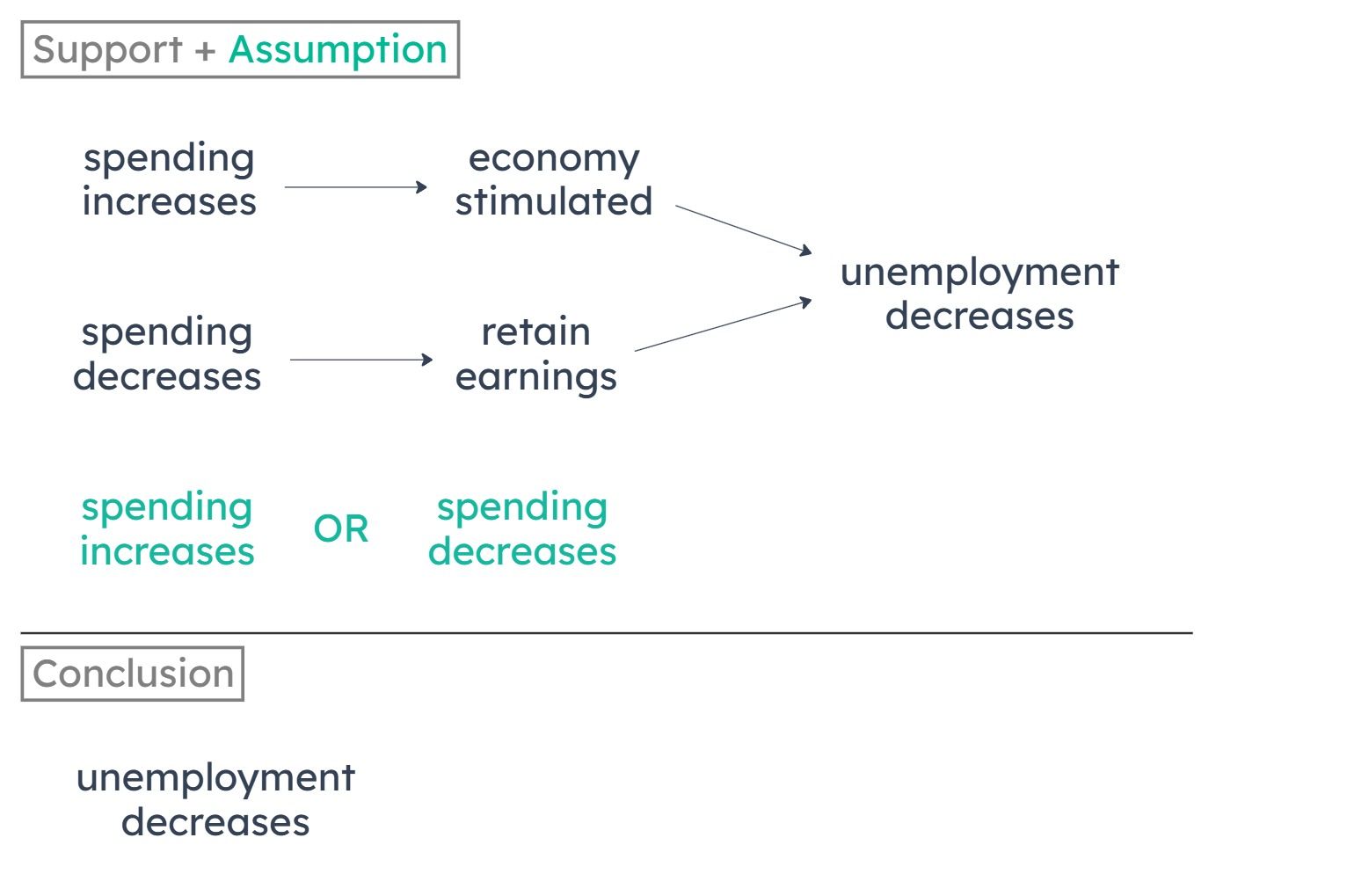Summary
The author concludes that unemployment will soon decrease. This is based on the following:
If total gov. spending significantly increases next year, unemployment will decrease.
If total gov. spending significantly decreases next year, unemployment will decrease.
If total gov. spending significantly increases next year, unemployment will decrease.
If total gov. spending significantly decreases next year, unemployment will decrease.

Missing Connection
We have two triggers that can prove unemployment will decrease — gov. spending significantly increases or it significantly decreases next year. But do we know that either of those will actually occur? No. So to make the argument valid, we want to know that next year, gov. spending will significantly increase or it will significantly decrease.
A
Either total government spending will significantly decrease next year or else total government spending will significantly increase next year.
(A) establishes that one of the two triggers for a decrease in unemployment will occur. So it must be true that unemployment will decrease next year.

B
Government officials are currently implementing policies that are intended to reduce unemployment.
(B) doesn’t establish that one of the two triggers for a decrease in unemployment will occur.
C
If there is a significantly increased demand for workers, then there will be a significant decrease in unemployment.
Although (C) tells us that IF there’s a significant increase in demand for workers, there will be a significant decrease in unemployment, we don’t have a premise establishing that there will be a significant increase in demand for workers.
D
A significant increase in total government spending will slow the economy in the long run.
(D) doesn’t establish that one of the two triggers for a decrease in unemployment will occur.
E
If the economy is not stimulated and businesses do not retain more of their earnings, then unemployment will not decrease.
(E) doesn’t establish that one of the two triggers for a decrease in unemployment will occur. (E) is designed to reach a conclusion that unemployment will NOT decrease. But we’re trying to show that unemployment WILL decrease.
"Surprising" Phenomenon
Patients in Woodville’s semiprivate-rooms-only hospital experience the same infection rates and lengths of stay as patients at nearby hospitals where most of the rooms are private, even though hospital patients tend to have lower infection rates and require shorter hospital stays when they are housed in private rooms.
Objective
The right answer will describe some factor that does one or more of the following: improves infection rates and lengths of stay at Woodville, worsens these metrics at the nearby hospitals with mostly private rooms, or shows why Woodville’s semiprivate rooms do not impact the metrics in question the way other hospitals’ semiprivate rooms do. This factor will serve to counteract the effects of the different room privacies to yield the same infection rates and lengths of stay across the hospitals.
A
Many of the doctors who routinely treat patients in Woodville’s hospital also routinely treat patients in one or more of the nearby hospitals.
This answer does the opposite of what we need. We might’ve been able to explain the nearly identical infection rates and stay lengths by saying that Woodville has superior doctors, but this answer takes away that possibility by saying that many of the doctors are the same.
B
Most of the nearby hospitals were built within the last 10 years, whereas Woodville’s hospital was built about 50 years ago.
This might explain why Woodville’s room layout is different from those of the nearby hospitals, but it doesn’t help explain why the lengths of stay and rates of infection at Woodville are largely the same.
C
Infection is more likely to be spread where people come into close contact with one another than where they do not.
This might help explain why infection rates tend to be worse among patients in semiprivate rooms, but it doesn’t help explain why that effect doesn’t make Woodville’s infection rates worse than those at nearby hospitals.
D
Woodville’s hospital has a policy of housing one patient per room in semiprivate rooms whenever possible.
This offers an explanation of why Woodville has the same infection rates and stay lengths as nearby hospitals despite the difference in its floorplan: even though Woodville has only semiprivate rooms, they use them as though they were private whenever possible.
E
Woodville’s hospital is located in its central business district, whereas most of the nearby hospitals are located outside their municipalities’ business districts.
This doesn’t offer anything to counteract the impact we would expect semiprivate rooms to have on infection rates and stay lengths at Woodville in comparison to nearby hospitals.